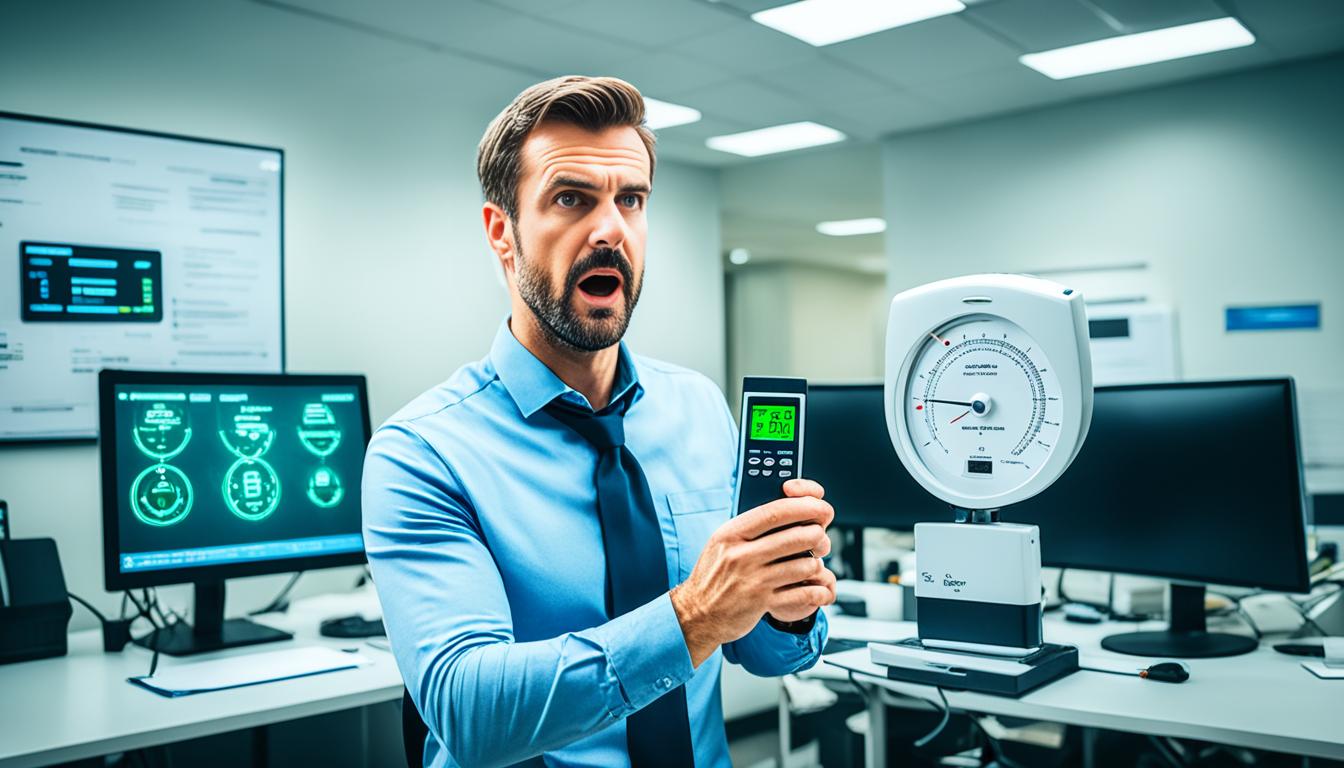Disclosure: This Post Contains Affiliate Links; We earn a commission on purchases.
Welcome to the world of tech, where innovation and connectivity reign supreme. As a tech professional, you’re likely familiar with the constant exposure to electromagnetic fields (EMF) and the potential health risks associated with them. But did you know that you can take steps to create a low-EMF workspace that promotes your well-being without compromising on productivity?
In this article, we’ll explore the importance of reducing electromagnetic fields in your workspace and provide you with practical strategies to design an EMF-free office environment. From shielding solutions to workplace safety measures, we’ll cover it all to help you prioritize your health while staying connected.
Key Takeaways:
- Create a low-EMF workspace to minimize exposure to electromagnetic fields.
- Reduce electromagnetic radiation from wireless sources such as Wi-Fi and Bluetooth.
- Consider using wired internet connections instead of relying solely on Wi-Fi.
- Utilize EMF shielding solutions to protect yourself from harmful electromagnetic radiation.
- Be mindful of the placement of electrical equipment and devices in your workspace.
Set Up Your Computer Workstation for Safety and Health
Creating a safe and healthy computer workstation is essential for tech professionals. By following these steps, you can minimize potential health risks and optimize your workspace for productivity.
1. Choose the Right Setup
Start by selecting a table and chair for your workstation. Avoid using your lap as a surface to place your devices. Opt for a sturdy table that allows for proper posture and ergonomics. Pair it with a comfortable chair that provides adequate back support.
2. Minimize EMF Exposure
Reduce electromagnetic field (EMF) exposure by keeping electrical wires and equipment at a safe distance from your body. This helps to minimize the impact of electromagnetic radiation.
Tip: Use a corded telephone instead of cordless or cell phones to decrease wireless radiation.
3. Reduce Blue Light
Blue light emitted by screens can disrupt sleep patterns and cause eye strain. Protect your eyes by using blocker films or glasses that reduce exposure to blue light. This helps to improve sleep quality and minimize eye fatigue.
4. Connect Peripherals with Cords and Cables
In order to minimize wireless radiation, connect your tech peripherals such as keyboards, mice, and printers with cords and cables. This reduces the amount of wireless signals in your immediate vicinity.
Tip: Ensure there is sufficient background light when using a computer to prevent eye strain.
Understand the Types of EMF from Screens and Computers
When it comes to screens and computers, there are different types of electromagnetic fields (EMF) that we need to be aware of. These EMFs can have an impact on our health and well-being. Let’s take a closer look at the two main types of EMFs from screens and computers: wireless radiation (RF-EMF) and extremely low frequency electric and magnetic fields (ELF-EMF).
Wireless Radiation (RF-EMF)
Wireless radiation, also known as radiofrequency electromagnetic fields (RF-EMF), is emitted from various sources such as Wi-Fi, Bluetooth devices, and cellular antennas. These signals are used to transmit data wirelessly. While these technologies have revolutionized the way we communicate and access information, they also expose us to RF-EMF.
Extremely Low Frequency Electric and Magnetic Fields (ELF-EMF)
On the other hand, extremely low frequency electric and magnetic fields (ELF-EMF) are produced by the electrical systems in our screens and computers. These fields are present whenever a device is connected to an electrical power source.
Practical changes in how we set up our computer workstation can significantly reduce these types of EMF exposures. By understanding the sources of EMF and taking appropriate measures, we can minimize our exposure to wireless radiation and ELF-EMF.
It’s important to note that certain groups, such as children and pregnant women, may be more vulnerable to the effects of these EMFs. Therefore, it’s crucial to take extra precautions to protect these individuals.
The Importance of Low EMF House Design
In today’s modern world, where we are surrounded by technology and electronic devices, it is crucial to consider the impact of electromagnetic fields (EMFs) on our health and well-being. This is particularly important when designing our homes, as poor planning can lead to EMF issues in houses that can potentially have adverse effects on our health.
Low EMF house design focuses on minimizing EMF exposures within the home environment. By implementing certain design principles and strategies, individuals can create a living space that prioritizes their health and reduces unnecessary EMF exposures.
Reducing EMF Exposures in Your Home
When it comes to low EMF house design, there are several important tips to keep in mind:
- Install wired phone and internet connections in every room: One of the most effective ways to reduce EMF exposures is by using wired connections for communication and internet access. This eliminates the need for wireless devices that emit high levels of EMFs.
- Proper placement of electrical equipment: It is essential to carefully consider the placement of electrical equipment within your home. Avoid positioning electrical panels, wiring, and other devices in areas where you spend a lot of time, such as bedrooms or living rooms.
- Measure ELF and RF levels: Throughout the building process, it is advisable to measure the levels of extremely low-frequency (ELF) and radiofrequency (RF) radiation within your home. This will help ensure that these levels are within safe limits and that your living environment is EMF-friendly.
By following these low EMF house design tips, you can create a living space that reduces EMF exposures and promotes a healthier environment for you and your family.
“Creating a low-EMF house design is crucial for reducing unnecessary EMF exposures and promoting a healthier living environment.”

Reducing EMF exposures in your home goes beyond just minimizing health risks. It also helps create a peaceful and relaxing environment, free from the constant bombardment of electromagnetic radiation. By prioritizing low EMF house design, you are investing in the well-being of your family and creating a space where they can thrive.
Designing a Low-EMF Office Environment
Creating a low-EMF office environment is essential to protect against the potential health effects of electrostatic and electromagnetic energies. Individuals with EMF sensitivities, including those with Electromagnetic Hypersensitivity (EHS), may experience symptoms such as headaches, fatigue, and difficulty concentrating when exposed to high levels of EMFs.
In order to design a low-EMF office environment, it is important to identify and mitigate potential sources of EMFs. Wireless devices, heaters, speakers, and cell phones are common culprits that contribute to increased EMF exposure. By taking specific measures, individuals can minimize these risks and create a safer workspace.
Here are some recommendations for designing a low-EMF office environment:
- Move the router away from the desk: Positioning the router at least 20 feet away from the workspace helps reduce EMF exposure from wireless signals.
- Use a wired phone: Opt for a corded telephone instead of relying on cordless or cell phones, which emit wireless radiation.
- Disable Bluetooth and wireless on phones: Turning off Bluetooth and wireless functions when not in use further minimizes exposure to EMFs.
- Use ceramic heaters: Choose ceramic heaters instead of traditional space heaters, which often emit high levels of EMFs.
- Plug speakers away from the desk: Positioning speakers at a distance from the desk helps reduce EMF exposure.
By implementing these measures, individuals can create a low-EMF office environment that promotes better health and well-being. Minimizing exposure to electrostatic and electromagnetic energies can alleviate symptoms associated with EHS and contribute to a more productive work environment.
“Creating a low-EMF office environment is crucial for protecting against the potential health effects of EMFs. By taking simple measures, individuals can significantly reduce their exposure and create a safer and healthier workspace.”
The Impact of EMFs on Health and Wellness
Electromagnetic fields (EMFs) have been a topic of concern due to their potential impact on health and wellness. When exposed to EMFs, cells in the body react as if they are being exposed to potentially harmful stimuli, triggering a biochemical stress response.
Scientific evidence suggests that EMFs can have various biological effects on the body. One such effect is oxidative stress, which occurs when there is an imbalance between the production of reactive oxygen species (ROS) and the body’s antioxidant defense system. Oxidative stress has been linked to various health conditions.
Another area of concern is the blood-brain barrier permeability. The blood-brain barrier acts as a protective barrier between the bloodstream and the brain, regulating the passage of substances. Studies have indicated that EMFs can disrupt the integrity of the blood-brain barrier, potentially allowing harmful substances to enter the brain.
EMFs have also been associated with genotoxic and fertility effects. Genotoxicity refers to the ability of agents to damage genetic material, potentially leading to mutations or other harmful effects. Some studies have suggested that EMFs may have genotoxic effects, although further research is needed. Additionally, there is evidence linking EMFs to reduced fertility in both men and women.

Heat shock proteins are another area of interest regarding the impact of EMFs. These proteins are responsible for preventing cellular damage caused by stressors, including EMFs. Research has shown that exposure to EMFs can induce the production of heat shock proteins, suggesting a protective cellular response.
Furthermore, there is evidence of changes in the autonomic nervous system caused by EMFs. The autonomic nervous system regulates involuntary bodily functions, such as heart rate, digestion, and respiratory rate. Studies have indicated that EMFs can influence the autonomic nervous system, potentially affecting these bodily functions.
Lastly, some individuals may experience symptoms of electromagnetic sensitivity when exposed to EMFs. These symptoms can include headaches, fatigue, dizziness, and difficulty concentrating. While electromagnetic sensitivity is not widely recognized as a medical condition, some people report experiencing significant discomfort when exposed to EMFs.
Summary:
EMFs can have various biological effects on health and wellness. These effects include oxidative stress, blood-brain barrier permeability, genotoxic and fertility effects, the induction of heat shock proteins, changes in the autonomic nervous system, and the potential for electromagnetic sensitivity. Further research is needed to fully understand the long-term consequences of EMF exposure and to develop strategies for minimizing potential risks.
Tips for Reducing EMF Exposures in the Workplace
Creating a low-EMF workplace is essential for maintaining a healthy work environment. By taking specific steps to minimize electromagnetic field (EMF) exposures, tech professionals can prioritize their well-being and reduce potential health risks. Here are some tips to help reduce EMF exposures in the workplace:
- Move router or wifi booster: Position your router or wifi booster at least 20 feet away from your desk to minimize exposure to wireless signals.
- Use a wired phone: Opt for a wired phone instead of a cordless phone to avoid unnecessary wireless radiation.
- Disable Bluetooth and wireless on phones: Turn off Bluetooth and wireless connections on your phones when not in use to minimize EMF emissions.
- Use a ceramic space heater: Instead of using traditional electric heaters, consider a ceramic space heater that emits less EMF.
- Plug speakers away from the desk: Position speakers away from your desk to reduce EMF exposures during long periods of use.
By implementing these tips, you can significantly reduce your exposure to EMFs in the workplace and create a safer and healthier work environment for yourself and your colleagues.
Creating a low-EMF workspace is crucial for the health and wellness of tech professionals. By implementing strategies such as setting up a safe computer workstation, designing low-EMF office environments, and reducing EMF exposures in the workplace, individuals can create a healthier and more productive work environment.
Conclusion
Creating Low-EMF Workspaces is essential for the health and wellness of tech professionals. By implementing various EMF mitigation strategies, individuals can significantly reduce electromagnetic fields in their workspace and create a low-EMF office environment.
Setting up a safe and ergonomic computer workstation is the first step towards reducing EMF exposures. It involves using a table with a chair instead of placing devices on the lap, connecting tech peripherals with cords and cables, and using corded phones instead of wireless or cell phones.
Additionally, designing a low-EMF office environment is crucial. This includes moving routers or wifi boosters away from the desk, disabling Bluetooth and wireless on phones, using ceramic space heaters, and plugging speakers away from the desk. By implementing these EMF shielding solutions, individuals can minimize electromagnetic radiation and create a safer work environment.
It is essential for tech professionals to be aware of the potential health effects of EMFs and take appropriate workplace EMF safety measures. By prioritizing the reduction of electromagnetic fields in their workspace, individuals can enhance their productivity and overall well-being. Creating a low-EMF office design is not only beneficial for tech professionals but also for everyone seeking an EMF-free and healthy workspace.
Source Links
- https://workinmind.org/2020/03/19/top-5-ways-to-boost-your-health-and-reduce-your-exposure-to-emfs-at-work/
- https://ehtrust.org/a-low-emf-computer-workstation/
- https://www.norad4u.com/emf-exposure-reduction/low-emf-house-design/

Subscribe to Our Newsletter










